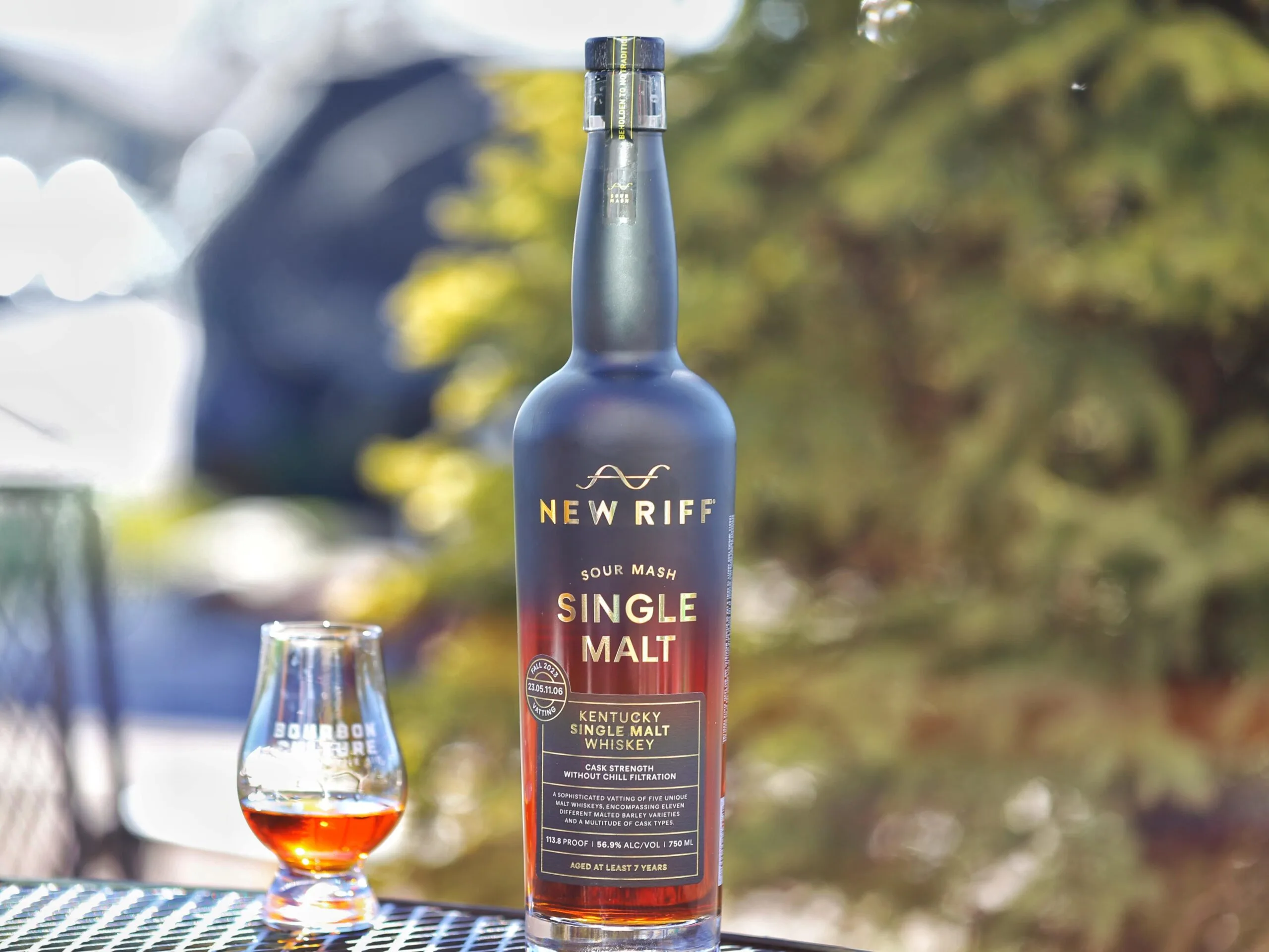| Don't like ads? | No ads |
*Bourbon Culture is reader-supported. When you buy through links on our site, we may earn an affiliate commission.
I must admit when I saw New Riff was putting out a new single malt whiskey, my first thought was “meh.” It was just another attempt by a Kentucky distillery to get bourbon enthusiasts drinking malt whiskey. I didn’t even read any press releases about it because frankly, I wasn’t interested.
But my friend James rolled up with a bottle one day last December when we were meeting up for Ukrainian food (shout out to Olesya’s Kitchen in Columbus, Indiana) and poured me a sample. I had no idea about the scale of what it took to produce the contents of this bottle until I started to do my research for this review. Let’s just say that after reading the amazing backstory of this project, I became much more invested in it.
“Don’t Make Scotch!” – Ken Lewis’s only directive for the creation of New Riff’s Single Malt Whiskey
The problem I think many American distilleries are having with bringing their own malt whiskey to a retailer’s shelf near you is that enthusiasts weren’t really asking for this kind of whiskey. I know I’m not speaking on every whiskey drinker’s behalf, but the overwhelming majority of my friends have told me they have never even bought a bottle of American Single Malt Whiskey. This doesn’t bode well for the segment as a whole. If nobody is buying them, then retailers won’t want to stock them. They already have to prioritize space on their shelf for Scotch and so far American Single Malts haven’t done enough to show why they’re different.

I have a lot of opinions on why bourbon and rye enthusiasts aren’t buying, but it mostly boils down to domestic distilleries having a hard time educating consumers. And I get it, it’s tough. Most consumers won’t read a review like this to learn more. Instead, they’ll stand in a liquor aisle with a $60 12-year-old bottle of Scotch in one hand and a $60 3-year-old bottle of American Single Malt in the other and pick the Scotch every single time.
The crew at New Riff put their collective minds together in 2014 to establish a game plan on how they’d like to make their single malt different. But even more than that, they have been documenting their journey on what they’re doing on their website. It might be a lot for a new whiskey consumer to understand, but nerdy enthusiasts thrive on this stuff. So what makes this stuff so different?
New Riff’s recipe to making the perfect Single Malt requires many recipes
I’m going to keep this story more succinct than their website does in the hopes that I don’t make this a book. The guys at New Riff decided on a few fundamentals to how they were going to create a malt whiskey product. The first idea was to not use just one grain type and maturation method – for this release they would use five different grain types and a combination of six different cask types. Here’s the breakdown:
Types of Malted Barley Used:
- Maris Otter – A strain of malted barley commonly used in English Ales in the 1960s. Grassy, grainy character
- Golden Promise – A strain of malted barley most commonly used in the Scotch Whisky industry in the 1960s. New Riff points out that Macallan used only this grain for their Scotch once upon a time
- Barleywine Style – Two Row malted barley in both toasted crystal malt and heavily roasted chocolate malt varieties. These are commonly found in beer bearing the same name
- Belgian Quadrupel – I’m not even going to try to explain all of the terms that New Riff throws out there with this style. Just know that they claim it creates a dark, deep (yet mellow?!) impression to the whiskey
- Scottish Peated Malted Barley – Ken Lewis may have told the team he didn’t want them to make a Scotch, but many members still thought a peated malted barley component was going to be vital to the final blend. A majority of Scotch is not peated, but Scottish whiskymakers know that it can be vital in creating a signature style and taste.
Types of Casks Used:
- New Charred Oak
- Used De-charred/toasted (the old char was shaved off the inside and it was given a toasted treatment)
- Used De-charred/re-charred (the old char was shaved off the inside and then re-charred)
- Red Wine barrels made from French and American Oak
- Brandy Casks from Portugal
- Freshly dumped Oloroso Sherry Casks
Blending together the base whiskey and top dressing
If you know a lot about Scotch, then you already know that not all Scotch is created equal. For many larger brands, their core lineups usually contain two styles of malt whiskey that are married together to create a signature flavor profile. The first style is a base whiskey which, frankly, doesn’t have the heavy body or complexity that the other style has (more on that in a minute). It’s designed to stretch out a blend by being inoffensive and complimentary to whatever it’s mixed with. It usually gets those traits from being matured in worn-out ex-whiskey barrels (usually seeing 3 or 4 previous uses). Most of the time its appearance is very pale in color – which is why Scotch producers add coloring to many of their products.

The second style of whiskey is what I would call a “Character Malt” but New Riff refers to as a “Top Dressing.” What does it mean? It’s usually whiskey of exceptional character and profile. I would go even farther by saying that it’s a uniquely rich and expressive whiskey. Most of the time this type of whiskey has been matured in freshly dumped barrels like bourbon or Sherry. This contributes to their mouthfeel and flavor. Simply put, these types of whiskies are designed to stand out, not to hide in the background.
New Riff studied these concepts and decided to use them in the creation of their Single Malt. They tasted through their barrels and divided them into the two groups I mentioned above. Then they experimented with the final ratios of each to achieve their perfect version of balance. The crew initially had a plan before any of the barrels ever reached maturity that the Maris Otter and Golden Promise would probably be used as the base malt and the Barleywine and Belgian Quad would be used as the Top Dressing. But as they say in the Army “No plan survives first contact.” As the tasting crew sampled through their barrels, they found some of the whiskies didn’t mature in the way they thought they would. Some of the intended base malts tasted more like a Top Dressing and vise versa. Their final blend ended up being:
- Base Malt: Belgian Quadrupel (27.8% of the total blend)
- Base Malt: Golden Promise (35.5% of the total blend)
- Top Dressing: Maris Otter (16.8% of the total blend)
- Top Dressing: Barleywine (9.1% of the total blend)
Notice I didn’t include the peated malt in that list. That’s because the plan the blending crew came up with was that they would add the peated component as needed at the end. Initially, they figured it would require only a very small amount. But they found it wasn’t as overwhelming as they thought it would be. So they kept adding more until they were satisfied. In the end, a full 10.8% of the blend consisted of that kind of whiskey.
New Riff Sour Mash Single Malt Whiskey is born
One last thing before we get on to the review: I spent a lot of time covering the malt whiskey types, but remember how I said another component to how these whiskies would taste involved the cask they were aged in? New Riff broke down the percentage of whiskies that were matured in those (wine) casks (and I’m counting Brandy in this, too) and it ended up being 38.3%. Having over a third of the blend experiencing some type of influence from these Wine/Sherry/Brandy casks is quite significant, leading me to believe I’m in for a wild ride of fruits flavors and scents.
So there we have it, a single malt that is not only made up of dozens of combinations of malted barley types and maturation casks, but one that has also seen significant aging. I’m not saying it’s the oldest American Single Malt available (there are plenty of West-Coast and Colorado ones that surpass it), but it certainly is in the top third of ASM age statements out there. Keep in mind that the 7 year age statement is just the minimum and it’s said that there are barrels as old as 9 years in this final blend.
So how does it taste? Let’s finally find out.
Tasting Notes
Nose: Initially, the nose is pretty muted. It requires multiple visits and swirling to coax the notes that follow: First off, there is a lingering sweetness that changes between caramel and honey. The caramel would hint at the new charred oak (and possibly re-charred oak) barrels. The honey is typical for malted barley. The spices are light – think nutmeg and vanilla – that accompany the scents of a warm, chocolate Danish. For having a range of wine and brandy cask influence, I must say that the fruit notes are hard to find. I can barely detect scents of sweet wine and cherries. They’re so faint. Who knows, maybe this will get stronger as the bottle has more air time.
Palate: Each sip delivers some really well-integrated flavors. This is a delight to drink in every way, even though it might not be something I could see myself often reaching for. But its pleasantness alone doesn’t atone this whiskey for its lack of punch. Sure, all the flavors like honey, chocolate, cereal grains and coffee seem delicious when I spell them out, but to an bourbon or rye drinker, the final crescendo of oak is missing. In its place are spices like cinnamon spice, peppercorn and a dash of chili powder. I can even sense a small amount of floral flavors floating around. It’s all very nice, but it feels like its missing something.
More perplexingly, I still am not picking up on much by way of fruit. There is a little bit of citrus zest (lemon) and some sweet, grapey flavors that pass by, but nothing that would even hint that this had a large portion of wine-finished whiskey in the mix. And speaking of “Where’s Waldo?”… where’s the peat? I actually prefer peated Scotch and was hoping to get a taste of ash or the passing puff of campfire smoke, but there’s really none to be found. Bummer.
Finish: The finish is delicious and well-sorted, but not exactly mind-blowing. It does its job and it does it with precision. I finally taste a (light) oak tannic flavor accompanied by honeycomb notes. Lingering floral flavors accompany a more substantial chocolate note. Enjoyable? Yes. Exciting? Not as much.
Score: 7.4/10
I’m going to give New Riff a backhanded compliment when I say that this is an extremely competent American Single Malt – perhaps one of the best in the segment. But there is nothing exciting or captivating about it. And maybe that’s a crappy thing to say about a brand with a team that was this dedicated to their craft. I just feel like the description and process of what this whiskey was going to be practically ensured its greatness, but I have to trust what my nose and tongue tells me. This is a very nice whiskey that seems to be missing an “it” factor.

Final Thoughts
I feel like a robot on repeat when I end my New Riff reviews by always saying how much I respect them for keeping the prices down on experiments like these. On behalf of the entire enthusiast community, thank you for taking the risks with the projects you do, but not passing off the cost of those risks to us. For that, you have a customer for life.
I have no doubt that Single Malt Sour Mash will be something amazing some day. Reading the description beforehand made me want to automatically rate this like an 8.5 out of 10. But there was just something missing that I think the team intended to show us, but couldn’t. Maybe that requires longer maturation or a different blend… I’m not sure. But I learned a lot and can’t wait to try the next release because I still have high hopes that they’ll make it even better with the next one. So stay tuned.
Featured Products
- Neat Traveler

- View Larger
- Description:The Aged & Ore Neat Traveler is a complete travel kit for spirits. We combined our widely praised Neat Glass with one of our 3oz Flight Bottles and housed them together in a custom EVA travel case. Perfect for a night away with your favorite pour. The tie
- Bottle Flight

- View Larger
- Description:The Aged & Ore Bottle Flight is a premium set of 4 custom silicone wrapped glass bottles designed to transport and share samples of your favorite spirits. The flight bottles come in a custom EVA travel case that fits perfectly in any small bag. An Aged &
- Travel Bundle

- View Larger
- Description:This Bundle combines two of our crowd favorite products, creating the ultimate travel bundle to bring along your favorite spirits and glassware. Bundle Includes: Neat Traveler (Gray) Bottle Flight (Gray) Note: This bundle is only available in gray and col
*Bourbon Culture is reader-supported. When you buy through links on our site, we may earn an affiliate commission.

